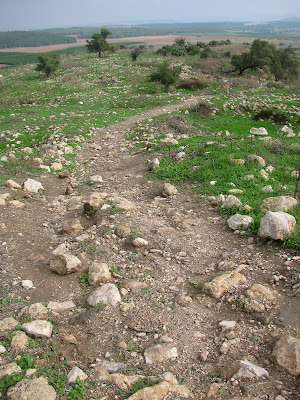Tel Tzafit, or in Arabic Tell es-Safi, which means "clear or
bright mound", is thought to be the site of the ancient Philistine city
of Gath. Gath was one of the five Philistine cities in the southern coastal
plain - the others being Gaza, Ashkelon, Ashdod and Ekron. The five cities
are often referred to as the Philistine
Pentapolis.
Archaeological excavations show that the
tel, or
archaeological mound, was continually inhabited since the 5th millennium
BCE. It appears on the Madaba Map as Saphitha, while the Crusaders called it Blanche Garde, the "White Fortress". Under
the Ottoman Empire it was part of the district of Gaza and in modern times the
villagers were Muslim and cultivated cereals and orchards. They had a
mosque, a marketplace and
a shrine for a local sage called Shaykh Mohammad. The Arab population was
expelled during the 1948 War of Independence, when the village was conquered by the
Givati brigade,
and later levelled. Today the site is an Israeli national park and
the site of ongoing archaeological excavations.
A small columbarium (housing structure for doves and pigeons) carved
into one of the caves for fresh meat supply.
The clearly marked trail first took us past white chalky caves, along the
western and northern area of the hill. The chalk was used in ancient times to quarry building stones for
structures. The artificially carved caves were then used for storage of
grain and as reservoirs for the water supply. Large rocks full of fossils
sit in chunks around the opening of the caves. These are remnants of the
distant past when this area was completely under water.
We continued climbing towards the summit of the hill, which sits 700 feet
(210 m) above sea level. Periodic signs along the trail with quotations
from the Bible gave us information about the ancient city of Gath. From
the top there were impressive views from all sides and it was easy to
understand the strategic importance of the site, which commanded the main
north-south coastal road and also an important east-west route along the
valley of Elah to Jerusalem.
The sign on the observation platform shows directions, in Hebrew, to
the major Philistine cities – Gaza, Ashkelon, Ashdod and Ekron. They
are in order from top to bottom, also from south to north.
An Arab graveyard was located on the fringes of the ruined Arab
village. Some remains of the tombs are still standing on the
hillside.
We took a break at the observation platform on the summit of the hill to
enjoy the views of the
coastal plain, the Shfela (the
Lowlands) and the
Judaean Hills
in the distance. The summit was where an ancient acropolis was once located,
and was also the location of the Crusader fortress. Continuing along the
trail we passed the remains of the Arab village, as well as more ancient
remains, below. The Arab village was built on the ruins of the Crusader
village and fortress. The villagers reused the ancient stones and added
sun-dried mud bricks to build their houses. An Arab graveyard was located
around the summit and some of the tombs are still there.
Further down the hill various excavations have unearthed Philistine style
ceramics, including a fragment of a clay bowl, dated to 950 BC, with ancient
alphabetic letters cut into it spelling two words which are etymologically
close to the name Goliath. This supports evidence of settlement by the
Philistines in Gath. Another interesting find was an ivory bowl cut from a
section of a tusk of an Indian elephant which is dated to 1100 BC. Yet more
evidence of the Philistine culture was found in the form of a cooking
installation known as a 'pebbled hearth' - a round pile of small stones on
which they cooked their food.
Along this part of the trail were groups of cactus bushes. The cactus bush
was a typical fence used in Arab villages.
From this point it was a short walk back to our car, first passing more
caves and an orchard. It was raining pretty heavily but, once back in the
car, I couldn't resist stopping at an ancient well located near to the
entrance to the park. The well, "Bir Tel Tzafit", below, was an
Antilia
type well and was used by the villagers as their source of water. A water
wheel, also known as the Antilia, was used to fetch the water from the
bottom of the well using cogwheels and animal power - donkey or camel - to
raise water from the well and fill up a nearby pool. From the pool the water
was channelled to agricultural fields, or used for households or livestock.
Around the well are the remains of the structures that operated with the
various parts of the Antilia.
* This post has been shared on
Nature Notes,
The Joys of Spring,
The Good. The Random. The Fun., Wordless Wednesday (on Tuesday), Our World Tuesday, Tuesday's Treasures, Pictorial Tuesday and My Corner of the World.
































































